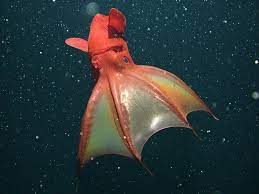A vampire-like ancient squid stalked Earth’s oceans 165 million years ago, according to new fossil studies. According to the study, which was published in the journal Papers in Palaeontology in June, the organism had a bullet-shaped body with glowing organs, eight arms, and sucker attachments. Scientists in France made the discovery by analyzing previously discovered fossils using current imaging techniques.

The ancient squid was given the name Vampyrofugiens atramentum, which means “fleeing vampire.” According to the researchers, these characteristics have never been observed previously.
The newly found species is said to have grabbed live prey with its arms. According to the study, it also featured protective traits such as glow-in-the-dark organs.
Vampyrofugiens was also discovered to have an ink sac as a unique defense characteristic.
The first time bioluminescence and ink were combined was in extinct coleoids.
“It was both predator and prey,” Alison Rowe, a doctorate candidate at the Palaeontology Research Center in Paris (CR2P), said in an interview with Live Science.
“It’s (the two features) unique because it has a number of anatomical features that we haven’t seen in the fossil record,” she noted.
According to the study, V atramentum could have used the luminous organs to communicate by sending out light signals in the dark ocean, as well as to hide from predators by mimicking natural light from the surface.
This research sheds new information on the evolution of coleoid cephalopods like octopuses, squid, and cuttlefish.
According to Ms Rowe and her colleagues, V atramentum lived in the open ocean and likely ate fish, crabs, and possibly smaller cephalopods, while being prey to larger fish and cephalopods.
